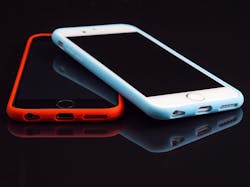Smartphone app can vibrate a single drop of blood to determine how well it clots
Researchers have developed a new blood-clotting test that uses only a single drop of blood and a smartphone with a plastic attachment that holds a tiny cup beneath the phone’s camera, according to a news release from the University of Washington.
Blood clots form naturally to stop bleeding when someone is injured. But blood clots in patients with medical issues, such as mechanical heart valves or other heart conditions, can lead to a stroke or heart attack. That’s why millions of Americans take blood-thinning medications, such as warfarin, that make it harder for their blood to clot.
Warfarin isn’t perfect, however, and requires patients to be tested frequently to make sure their blood is in the correct range — blood that clots too easily could still lead to a stroke or a heart attack while blood that doesn’t clot can lead to extended bleeding after an injury. To be tested, patients either have to go to a clinic laboratory or use a costly at-home testing system.
That is why researchers at the University of Washington developed the new blood-clotting test that uses only a single drop of blood and a smartphone vibration motor and camera.
This is how it works: A person adds a drop of blood to the cup, which contains a small copper particle and a chemical that starts the blood-clotting process. Then the phone’s vibration motor shakes the cup while the camera monitors the movement of the particle, which slows down and then stops moving as the clot forms. The researchers showed that this method falls within the accuracy range of the standard instruments of the field.
The team published these findings in Nature Communications.
“Back in the day, doctors used to manually rock tubes of blood back and forth to monitor how long it took a clot to form. This, however, requires a lot of blood, making it infeasible to use in home settings,” said senior author Shyam Gollakota, UW Professor in the Paul G. Allen School of Computer Science & Engineering. “The creative leap we make here is that we’re showing that by using the vibration motor on a smartphone, our algorithms can do the same thing, except with a single drop of blood. And we get accuracy similar to the best commercially available techniques.”
Doctors can rank blood-clotting ability using two numbers:
- the time it takes for the clot to form, what’s known as the “prothrombin time” or PT
- a ratio calculated from the PT that allows doctors to more easily compare results between different tests or laboratories, called the “international normalized ratio” or INR
The researchers wanted an inexpensive device that could work similarly to how at-home blood sugar monitors work for people with diabetes: A person can prick their finger and test a drop of blood.
To calculate PT and INR, the phone collects two-time stamps: first when the user inserts the blood and second when the particle stops moving.
The researchers tested this method on three different types of blood samples. As a proof of concept, the team started with plasma, a component of blood that is transparent and therefore easier to test. The researchers tested plasma from 140 anonymized patients at the University of Washington Medical Center. The team also examined plasma from 79 patients with known blood-clotting issues. For both these conditions, the test had results that were similar to commercially available tests.
To mimic what a patient at home would experience, the team then tested whole blood from 80 anonymized patients at both Harborview and the University of Washington medical centers. This test also yielded results that were in the accuracy range of commercial tests.
This device is still in a proof-of-concept stage. The researchers have publicly released the code and are exploring commercialization opportunities as well as further testing. For example, currently all these tests have been done in the lab. The next step is to work with patients to test this system at home. The researchers also want to see how the system fares in more resource-limited areas and countries.

